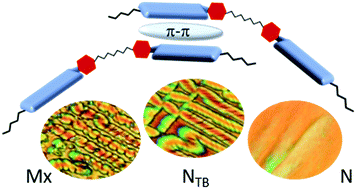Fine-tuning the effect of π–π interactions on the stability of the NTB phase†
Abstract
The synthesis and liquid-crystalline properties are reported for novel bent-shaped dimers in which a naphthyl group has been incorporated into the mesogenic cores. In addition to the nematic and twist-bend nematic phase, a new liquid-crystalline phase was observed. The combined experimental and computational study demonstrated how the interplay between the molecular geometry and π–π interactions affects the thermal stability of the twist-bend nematic and nematic phases. Correlation between mesomorphic properties and molecular geometry revealed that a greater conformational diversity leads to a broader distribution of bend-angles and destabilization of the NTB phase. Qualitative correlation between the thermal behaviour and electronic structure of the molecules of a similar geometry suggested that the transition temperatures of both nematic phases depend on the relative contribution of dispersion and electrostatic energies which determines the strength of the π–π interactions. These results provide an insight into how subtle changes in chemical structure can be exploited to tune the intermolecular interactions and influence the thermal stability of the liquid crystalline phase.



 Please wait while we load your content...
Please wait while we load your content...